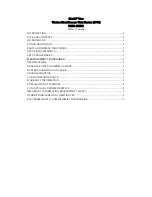
Theory o f Operati on-60S
CAT H O D E S U P PLY
The Cathode Supply voltage, -4500 volts, is produced
by voltage doubler C852-CR852-CR853. It is then
filtered by C854, R856, and C 85S, before being
applied to the crt cathode (pin 2 of V950). The
Cathode Supply is regulated by the Error Amplifier.
E R R O R AM P L I F I E R
Regulation o f the Cathode Supply voltage i s
accomplished by applying a sample o f the -4500 volts,
from voltage divider R 920A- R 920B, to the positive
input (pin 3) of U 832. If the output level of the
Cathode Supply exceeds the normal -4500 volts
( becomes more negative), the voltage at pin 3 of U 832
goes negative from its quiescent zero-volt level. This
results in a reduced output voltage from U832. A
lower potential from the Error Ampl ifier reduces the
conduction of the H igh-Voltage Osci llator, resulting in
a smaller peak-to-peak amplitude of the signal in the
secondary of T850 and returning the Cathode Supply
to -4500 volts.
C U R R E NT Ll M ITER
Transistor Q826 protects the High-Voltage Oscillator
transistors if excess current is demanded from the
secondary of T850, due to a short circu it or abnormal
load, by limiting the max i m u m current drawn by the
H igh-Voltage Oscillator.
CO NTR O L-G R I D DC R ESTO R ER
The Control-Grid DC Restorer couples the dc and low
frequency components of the Z-Axis Amplifier output
signal to the crt control gri d (pi n 3 of V950). This
a llows the Z-Axis Ampl ifi er to control the crt beam
intensity. The potential difference between the Z-Axis
Amplifier outpu t level and the crt control grid (about
-4500 volts) prohibits direct coupling.
The Control-Grid DC Restorer is actually a cathode
referenced bias supply for the crt control grid.
Quiescently, its output voltage is more negative than
the crt cathode by an amount determined by the Z
Axis Amplifier o utput l evel and the setting
of
the Crt
Bias adjustment, R862. (Th e cutoff voltage at the crt
control grid is typicaliy about 85 volts more n egative
than the crt cathode level.)
NOTE
A simplified diagram of the Control-Grid DC
Restorer is shown in Figure
4-4.
The
volt ages given on this diagram are idealized
levels and will not necessarily be the same
as those found in the actual instrument.
The Control-Grid DC R estorer is divided into two
sections for ease of explanation. The first section can
be considered a modulator at low-voltage potentia Is,
and the remain ing secti on as a demodulator at high
voltage potentials (see Fig. 4-4).
4-6
M od u lator
When the secondary winding output of T850 (pin
1 0)
swings positive, C 872 charges through R860 and
C860 to a voltage level determined by the setting of
the Crt B ias adj ustment, R862. At this voltage level
( approximately +85 volts), diode C R872 conducts,
preventing any additional increase in the positive
voltage across C872. When the secondary-winding
output swings negative, diode CR872 turns off. Then
CR860 conducts and clamps the negative excursion at
C872 to the voltage level of the Z-Axis Amplifier
output. The result is a squ are-wave output from the
M odulator; the output amplitude is determined by the
difference between the Z-Ax.s Amplifier output level
and the Crt Bias adjustment setting. (See waveform 2
on Fig. 4-4 . ) This square wave is coupled through
C872 to the Demodulator.
D emodul ator
The Demodulator rectifies the signal from the
M odulator and references it to the crt C athode S u pply
level. The positive swing of waveform 3, Figure 4-4, is
limited by C R 874 to the level of the Cathode S upply;
the negative excursion is coupled through CR876 to
CS79. Quiescently, C879 wi l l charge to about -4500
volts through R876. After repetitive cycles from C872,
C879 wi l l charge to the negative level of waveform 3 .
Capacitor C 879 filters the output o f the D emodulator,
and also provides a path for the high-frequency
portion s of the Z-Axis Ampl ifier output signal to be
coupled to the crt control grid.
The rema i nder of the components not shown on the
si mpli fi ed diagram in Figure 4-4 provide circu it
protection in the event of a h igh-voltage arc, or other
malfunction.
F O CU S - E L E M ENT DC R E STO R E R
The Focus-Element DC Restorer couples the d c a nd
low-frequency components of the Dynamic Focus
correction signals (diagram 4) to the crt focus element
of V950. T h i s allows the DynamiC Focus circu it to
control the focus-element potential. The potential
difference between the Dynamic Focus output and the
focus element (approximately 3250 volts) proh ibits
direct coupl ing.
The Focus-Element DC Restorer is divided into
2
sections for ease of explanation. The first section can
be considered a modulator at low-voltage potentials
and the remianing section a demodu l ator at high
voltage potentials (see Fig. 4- 5).
Modulator
When the secondary-winding output at T850 pin 10
swings positive, C 929 charges through R 927 and
C927 to a voltage l evel determined by the output level
from the S u mming and Output Ampl ifier stage of the
Dynamic Focus cir.cuit (diagram 4). At this voltage
level (approximately +15 volts for center-screen
deflection) C R 925 conducts, preventing any additional
@





































